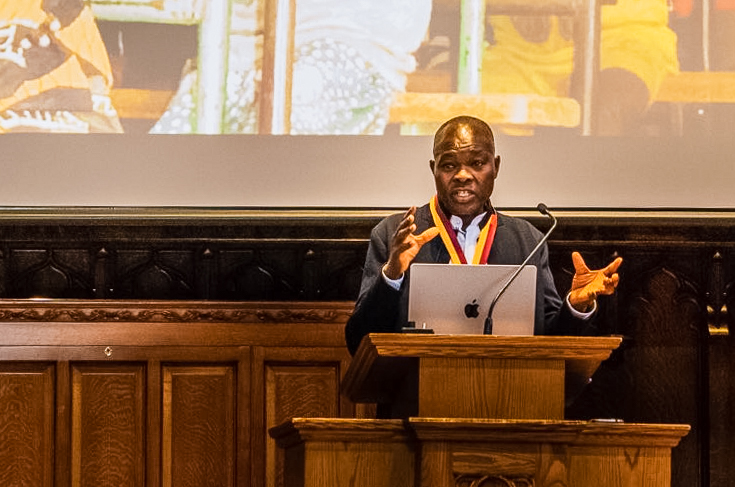News
Pritzker-winning architect Francis Kéré discusses his work and inspires students in lecture

Diébédo Francis Kéré speaks in Graham Chapel (Jimmy Hu | Student Life)
Diébédo Francis Kéré, the first African laureate of the Pritzker Architecture Prize, presented his architectural works and encouraged students to use their education for positive change when he spoke as part of Sam Fox School’s Public Lecture Series, April 1.
Kéré attended the Technical University of Berlin, and has since received many awards in architecture. He is also a visiting professor at several prestigious institutions in the United States and Switzerland. His work, frequently created under material scarcity, is renowned for its ability to be both elegant and socially conscious, while also connected closely to his home community in Burkina Faso.
Professor Adrienne Davis introduced Kéré, saying that “his vision for the world is one to which Washington University also aspires, a future that is sustainable, socially just, and in which we can all find ourselves in a strong and inspired community.”
Kéré began by acknowledging the help he received from his home community, teachers, and students in the past.
“I love colors, I love natural colors [in buildings] … but what I love the most is people, is you guys,” Kéré said. “I tried to use what I can do for the benefit of my people.”
He spoke about his own educational experience in Burkina Faso, having to travel nearly 25 miles to the next village to attend a school with almost no lighting and poor ventilation.
Kéré emphasized the significance of education, saying that he would not be here without it. He considered studying in Berlin a “privilege” and admitted that he has never considered “being an architect here in the West.” Instead, he wished to use his education to empower his community and country.
“Everything is possible if you have access to education,” Kéré said. “I was bringing light to places where there are no opportunities and education.”
In an effort to create an educational space for the children of his village, Kéré designed the Gando Primary School, constructed by locals mostly from the clay abundant in the region.
Recounting his experience overseeing the construction of Lycée Schorge, a secondary school in Koudougou, Burkina Faso, Kéré highlighted the participation of women in the process of construction.
“You can see that women gather … in a profession that is not seen as women’s domain,” Kéré said, showing a photo of the wooden chairs that the women designed and created for the Lycée.
Kéré also commented on the necessity of preserving the cultural heritage, expressed in different colors and elements, that is central to African identity.
The Benin National Assembly, a recent project under construction in Porto-Novo, Republic of Benin, embodies this ideal. The structure pays homage to palaver trees, used by communities across West Africa as venues for hosting communal gatherings.
Usually, the Occidental, Greco-Roman style is the norm for successful architecture in Africa. Architects are considered accomplished when their buildings resemble those found in the U.S., France, or Britain. Kéré wanted to be the exception.
“I was hoping to escape [from such practice] … let me build a structure that values nature, a structure that people can approach,” Kéré said.
By thinking outside of the convention, Kéré “was not just coping, but inspiring, to get fresh ideas relevant to what Africa is.”
Similarly, his Serpentine Pavilion in London adopted cultural elements that are native to Burkina Faso: one of them is the use of a deep blue façade, the color that represents the concepts of “celebration and optimism” in West Africa, according to Kéré.
Kéré’s used his ingenuity to design the Léo Surgical and Health Centre. Since there was a significant lack of materials in the area, he chose to construct it entirely out of clay, and added open spaces that could be illuminated by natural light so that the complex would not be seen as dull.
“This is my laboratory … a gift to my people,” he said. The presentation ended with a standing ovation.
Orion Strayer, a junior studying architecture at the Sam Fox School, has admired Kéré’s works for a long time and said that he was very inspired by the talk.
“I knew about Kéré before because I did one project analyzing his works in my sophomore year of architecture, and I think at that point, it was one of the most beautiful and socially effective works of architecture that I have seen,” Strayer said. “I was looking at Lycée Schorge, and the use of natural material, combined with the practicality of the structure — it’s simple and elegant and beautiful, and creates another experience for students.”
Strayer also said that Kéré’s talk helped him realize why architects are needed in our society. He believes that an architect should be the “caring human being on the other end” that designs buildings with love.
“If you love the people who will live in the building, then when those people enter that building, they will feel that love — for all of Kéré’s work, you can really feel that love, and that is the kind of architecture that I want to do,” Strayer said.
